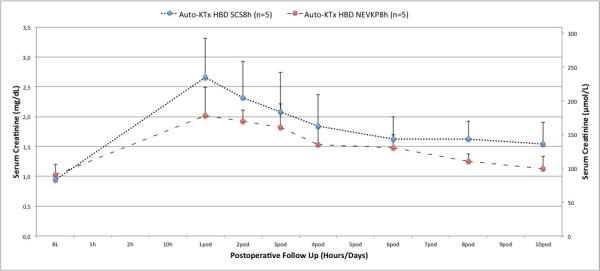Prolonged Normothermic Ex Vivo Kidney Perfusion Is a Safe Preservation Technique for Kidney Transplantation: A New Opportunity for the Storage, Assessment and Repair of Kidney Grafts.
1Department of Surgery, Multi Organ Transplant Program, Toronto General Hospital, University Health Network, Toronto, ON, Canada
2Division of Nephrology, The Hospital for Sick Children, Toronto, ON, Canada
3Institute of Medical Science, University of Toronto, Toronto, ON, Canada
4Department of General, Visceral, and Transplant Surgery, University Medical Center Mainz, Mainz, Germany
5Laboratory Medicine & Pathobiology, Toronto General Hospital, University Health Network, Toronto, ON, Canada
6Department of Medicine, Toronto General Hospital, University Health Network, Toronto, ON, Canada
7Departments of Surgery (Urology) &
Physiology, The Hospital for Sick Children, Toronto, ON, Canada.
Meeting: 2016 American Transplant Congress
Abstract number: C125
Keywords: Donation, Graft function, Kidney transplantation, Preservation
Session Information
Session Name: Poster Session C: Ischemia Reperfusion Injury and Organ Preservation
Session Type: Poster Session
Date: Monday, June 13, 2016
Session Time: 6:00pm-7:00pm
 Presentation Time: 6:00pm-7:00pm
Presentation Time: 6:00pm-7:00pm
Location: Halls C&D
Hypothermic kidney storage causes preservation injury. We investigated whether SCS can be safely replaced with prolonged normothermic ex vivo kidney perfusion (NEVKP). Right kidneys were removed from 30 kg Yorkshire pigs and either preserved in cold HTK solution for 8h, or subjected to 8h NEVKP followed by kidney autotransplantation. During NEVKP physiologic perfusion conditions were maintained with low intrarenal resistance and normal electrolyte and pH parameters. AST and LDH as injury markers were below the analyzer range during the perfusion (<4U/L and <100U/L). Perfusate lactate concentration decreased from baseline until the end of perfusion (10.38±0.76 mmol/l vs. 1.22±0.26mmol/l, p=0.0001). Post-transplantation, animals transplanted with NEVKP vs. SCS grafts demonstrated similar serum crea peak levels (NEVKP 2.0±0.5mg/dL vs. SCS 2.7±0.7mg/dL; p=0.114)  and crea clearance on day 10 (p=0.743). After 10 days follow-up animals transplanted with NEVKP grafts had crea values comparable to their basal levels, while serum crea of animals transplanted with SCS grafts had persistently elevated crea (p=0.013). NEVKP is a safe preservation technique for kidney transplantation and has the potential to minimize cold ischemic injury.
and crea clearance on day 10 (p=0.743). After 10 days follow-up animals transplanted with NEVKP grafts had crea values comparable to their basal levels, while serum crea of animals transplanted with SCS grafts had persistently elevated crea (p=0.013). NEVKP is a safe preservation technique for kidney transplantation and has the potential to minimize cold ischemic injury.
CITATION INFORMATION: Kaths J, Echeverri J, Goldaracena N, Louis K, Chun Y.-M, Linares I, Wiebe A, Yip P, John R, Mucsi I, Ghanekar A, Bagli D, Grant D, Robinson L, Selzner M. Prolonged Normothermic Ex Vivo Kidney Perfusion Is a Safe Preservation Technique for Kidney Transplantation: A New Opportunity for the Storage, Assessment and Repair of Kidney Grafts. Am J Transplant. 2016;16 (suppl 3).
To cite this abstract in AMA style:
Kaths J, Echeverri J, Goldaracena N, Louis K, Chun Y-M, Linares I, Wiebe A, Yip P, John R, Mucsi I, Ghanekar A, Bagli D, Grant D, Robinson L, Selzner M. Prolonged Normothermic Ex Vivo Kidney Perfusion Is a Safe Preservation Technique for Kidney Transplantation: A New Opportunity for the Storage, Assessment and Repair of Kidney Grafts. [abstract]. Am J Transplant. 2016; 16 (suppl 3). https://atcmeetingabstracts.com/abstract/prolonged-normothermic-ex-vivo-kidney-perfusion-is-a-safe-preservation-technique-for-kidney-transplantation-a-new-opportunity-for-the-storage-assessment-and-repair-of-kidney-grafts/. Accessed December 16, 2025.« Back to 2016 American Transplant Congress
